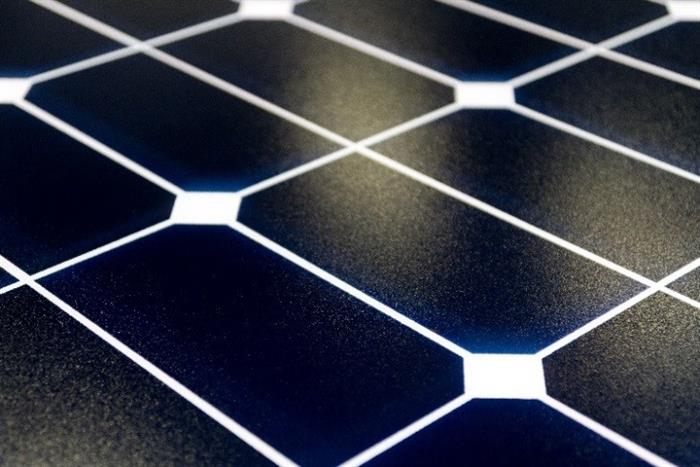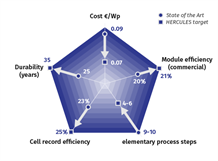With the ultimate goal of creating a premium European PV Technology, HERCULES PV (High Efficiency Rear Contact solar cells and Ultra powerful moduLES) aims to differentiate from the mainstream technologies used todays and bring a cost effective, reliable and sustainable solution. To reach these objectives, the project is articulated around two main n-type solar cell technologies regarding the second generation of high efficiency crystalline silicon solar cells and modules: heterojunction bifacial (SHJ) and Interdigitated Back contact (IBC). Moreover, it also deals with the combination of both in the so called Interdigitated Back contact Heterojunction (IBC-SHJ) concept for new ultra-high efficiency solar cells.
A n type solar cell is made of silicon including atoms that have one more electron in their outer level than does silicon, such as phosphorus. Thus, while atoms are bonding together, the electron not involved in this bonding is free to move inside the silicon structure.
A heterojunction bifacial solar cell (SHJ) is composed of mono-crystalline and amorphous silicon layers, which prevent recombinations of electrons and minimize the power loss.
An Interdigitated Back Content (IBC) eliminates shading losses by putting contacts on the rear of the cell, which make such cells useful in concentrator applications where the effect of cell series resistance is greater.

HERCULES has met its ambitious targets on SHJ technology with the development of high efficiency and low cost processes improving open circuit values over 735 mV thanks to very high passivation layers and improved n-type material. It developed large area solar cells with industrial-compatible processes reaching an efficiency of almost 23 % in the lab scale with improved metallization with copper as well as innovative module interconnection based on the so-called Smartwire approach. The project also improved encapsulation, bifaciality and module fabrication to reach a power of over 325 W in a 60-cells module passing all reliability tests.

It also demonstrated the industrial readiness of the process with the production of more than 100 000 SHJ cells in a production environment with mean efficiencies over 22 % and 22.9 % for the best cell in
busbar less configuration.
Schematic view of a busbar less (left) and busbar cells (right)
Regarding IBC technology, the project delivered well with the development of high efficiency and low cost approaches for IBC devices obtaining record efficiency values and reducing silver consumption. Cells with over 24 % efficiency were fabricated and simple and innovative IBC module solutions surpassing 310 W and fulfilling at reliability tests were developed. With the production of 1 200 IBC cells in industrial equipment with mean efficiencies of 21.4 % and 21.9 % best cell, its industrial readiness has also been demonstrated.
Finally, with the IBC-SHJ technology, high efficiency devices over 22.5 % were fabricated with innovative patterning designs. The first solutions for module encapsulation and interconnection were also proposed with positive and reliable results.
On the commercial aspect, a total cost of ownership below 0.4$/Wp for both technologies IBC and SHJ, taking into account a 500 MW capacity of production in Europe, have been demonstrated. The levelized cost of energy (LCOE) for Bifacial SHJ cells was also shown to reach values as low as 25€/MWp in high irradiation conditions.

Defina Muñoz, coordinator of the project, adds that
“Life Cycle analysis showed an Energy Payback Time lower than 1.5 years in medium irradiation for all HERCULES technologies! Thanks to the above mentioned outcomes, HERCULES brings interesting benefit and development perspectives for the EU PV research and industry stakeholders.” 
Silicon Heterojunction pilot line at CEA-INES. © CEA-Ines

From 2013 to 2016 and combining partners from Industry, Institutes and Universities with different strengths and competences this project has benefited from an European grant amounting to 7 M €. Today, continuing projects both at research and demonstration levels have already been jointly launched by the core partners to take HERCULES key results closer to the concrete application and market uptake.
| In short, the project aimed to - Improve efficiency and decrease fabrication cost at the solar cell and module level
- Bring SHJ & IBC technologies to a production environment level of analysis (TRL6)
- Analyse the performance, cost, sustainability and reliability of all HERCULES technologies
|